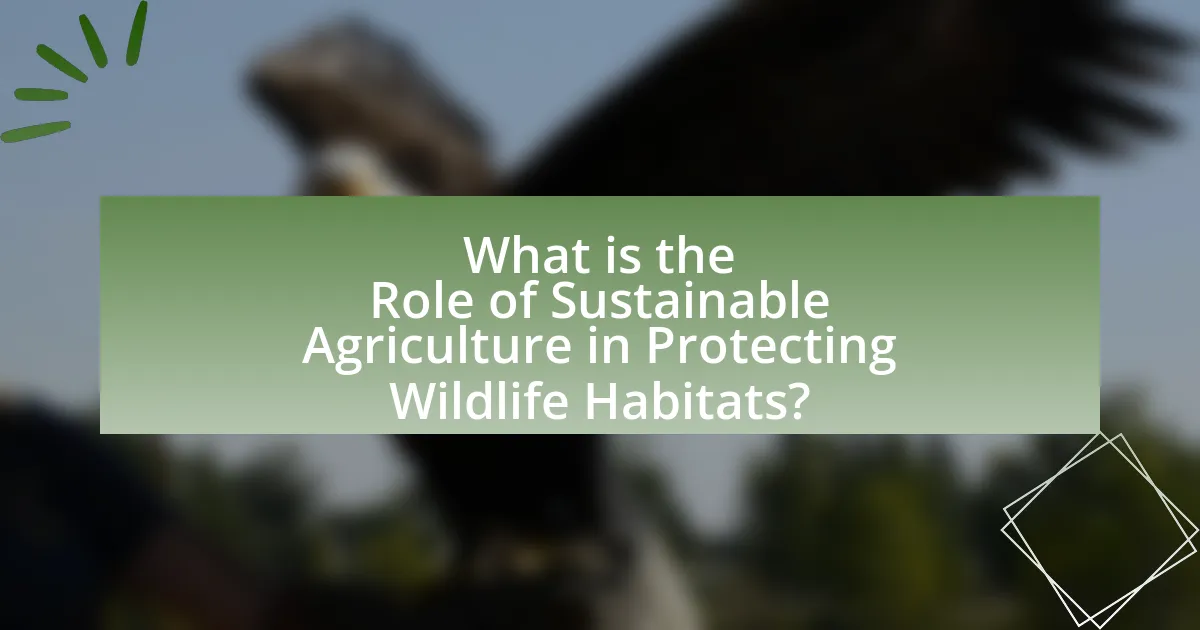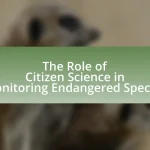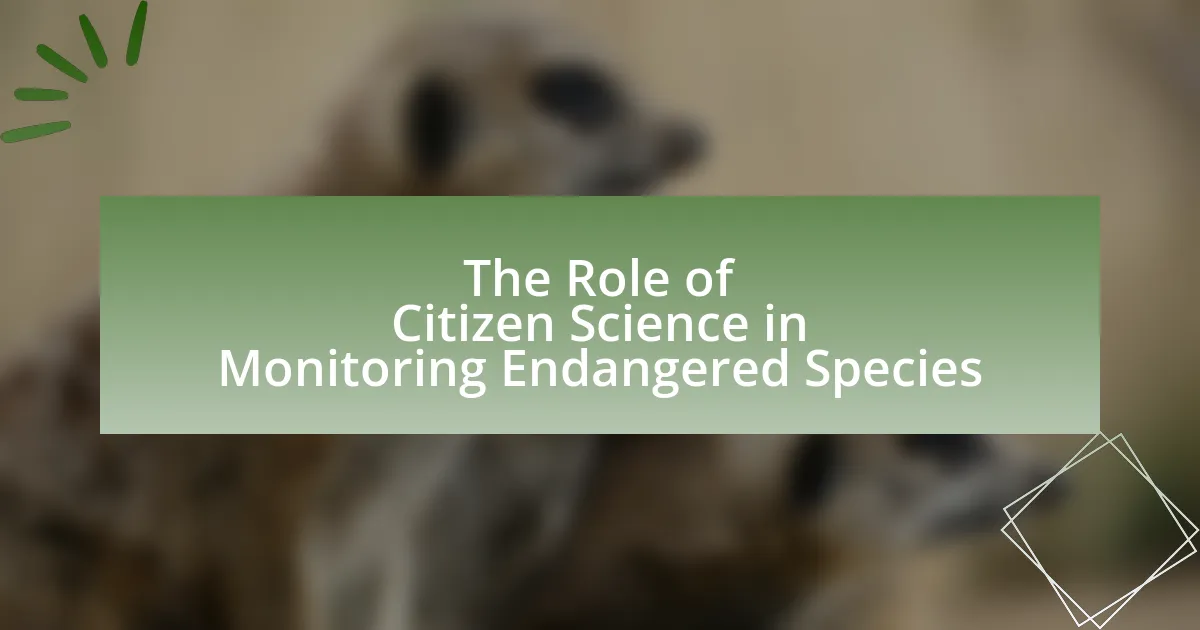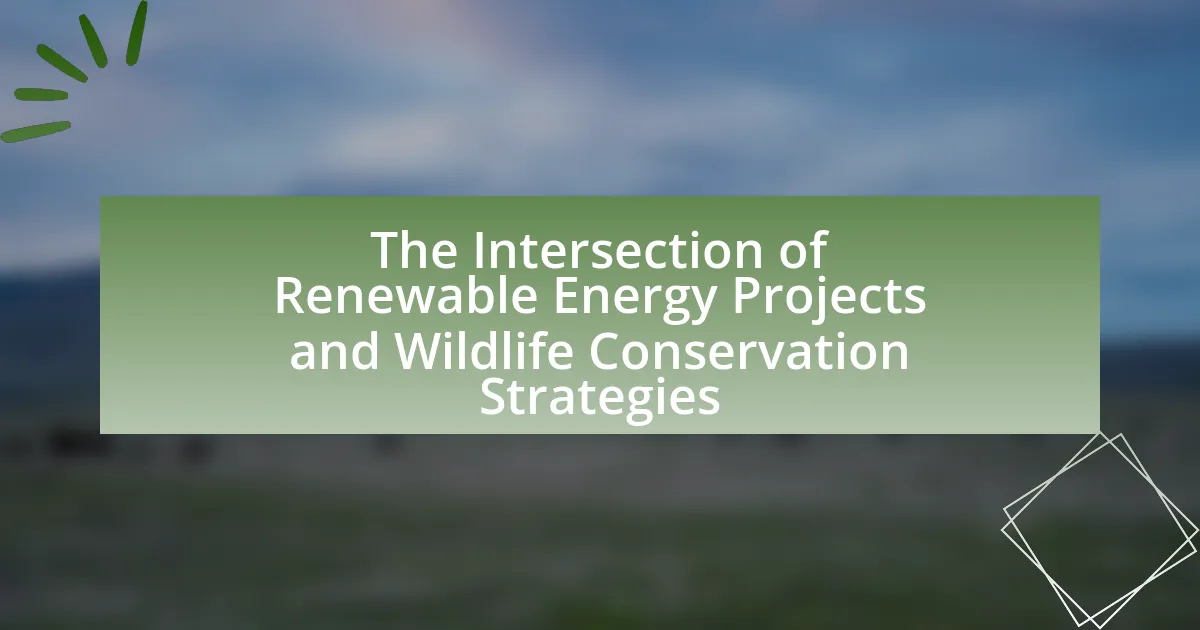Sustainable agriculture is a vital approach that significantly contributes to the protection of wildlife habitats by implementing practices that minimize environmental impact and enhance biodiversity. Key methods such as crop rotation, organic farming, and agroforestry not only reduce habitat destruction but also promote ecosystem integrity, allowing for increased species richness. The article explores how sustainable agricultural practices support wildlife habitat preservation, the ecological benefits of maintaining these habitats, and the challenges faced in balancing agricultural productivity with conservation efforts. Additionally, it highlights successful case studies and innovative techniques that demonstrate the effectiveness of sustainable agriculture in fostering biodiversity and protecting wildlife.

What is the Role of Sustainable Agriculture in Protecting Wildlife Habitats?
Sustainable agriculture plays a crucial role in protecting wildlife habitats by promoting practices that minimize environmental impact and enhance biodiversity. This approach reduces habitat destruction through techniques such as crop rotation, organic farming, and agroforestry, which maintain ecosystem integrity. For instance, studies have shown that organic farming can increase species richness by up to 30% compared to conventional methods, thereby supporting a wider range of wildlife. Additionally, sustainable agriculture often incorporates buffer zones and conservation areas, which provide safe habitats for various species, further contributing to wildlife protection.
How does sustainable agriculture contribute to wildlife habitat preservation?
Sustainable agriculture contributes to wildlife habitat preservation by promoting practices that enhance biodiversity and protect ecosystems. These practices include crop rotation, reduced pesticide use, and maintaining natural habitats such as hedgerows and wetlands, which provide essential resources for various species. Research indicates that farms employing sustainable methods can support up to 50% more wildlife compared to conventional farms, as they create a more balanced ecosystem that fosters the coexistence of agricultural activities and wildlife.
What practices in sustainable agriculture are beneficial for wildlife?
Practices in sustainable agriculture that are beneficial for wildlife include crop rotation, organic farming, and the establishment of buffer zones. Crop rotation enhances soil health and reduces pest populations, which supports diverse wildlife by providing a stable ecosystem. Organic farming minimizes chemical use, promoting healthier habitats for various species. Buffer zones, such as hedgerows and wetlands, create safe corridors for wildlife movement and improve biodiversity by offering shelter and food sources. These practices collectively contribute to the conservation of wildlife habitats and the overall health of ecosystems.
How does sustainable agriculture mitigate habitat destruction?
Sustainable agriculture mitigates habitat destruction by promoting practices that conserve biodiversity and reduce land conversion. Techniques such as crop rotation, agroforestry, and organic farming enhance soil health and ecosystem resilience, which in turn protect natural habitats. For instance, a study published in the journal “Nature” found that agroecological practices can increase species richness by up to 30% compared to conventional farming methods. Additionally, sustainable agriculture minimizes the use of harmful pesticides and fertilizers, which can degrade surrounding ecosystems, thereby preserving wildlife habitats.
Why is the protection of wildlife habitats important?
The protection of wildlife habitats is crucial for maintaining biodiversity and ecosystem health. Healthy habitats support a wide variety of species, which contributes to ecological balance and resilience. For instance, according to the World Wildlife Fund, approximately 1 million species are at risk of extinction due to habitat loss, highlighting the urgent need for habitat protection to preserve these species and their roles in ecosystems. Additionally, intact habitats provide essential services such as clean air and water, pollination of crops, and climate regulation, which are vital for human survival and agricultural productivity.
What are the ecological benefits of preserving wildlife habitats?
Preserving wildlife habitats provides critical ecological benefits, including biodiversity conservation, ecosystem stability, and climate regulation. Biodiversity is essential as it enhances ecosystem resilience, allowing environments to recover from disturbances; for instance, diverse ecosystems can better withstand diseases and climate change impacts. Ecosystem stability is maintained through the interdependence of species, where each organism plays a role in nutrient cycling and energy flow, contributing to overall ecological health. Furthermore, intact habitats act as carbon sinks, sequestering carbon dioxide and mitigating climate change effects. According to the Intergovernmental Science-Policy Platform on Biodiversity and Ecosystem Services, preserving natural habitats can significantly reduce greenhouse gas emissions, highlighting the importance of habitat conservation in addressing global climate challenges.
How does wildlife habitat protection impact biodiversity?
Wildlife habitat protection significantly enhances biodiversity by preserving ecosystems that support a wide variety of species. When habitats are protected, the natural environments necessary for species survival, reproduction, and migration are maintained, leading to increased species richness and abundance. For instance, studies have shown that protected areas can harbor up to 50% more species than unprotected areas, as these regions provide essential resources and reduce human-induced pressures such as habitat destruction and pollution. This correlation between habitat protection and biodiversity is evident in various ecosystems, including forests, wetlands, and grasslands, where conservation efforts have led to the recovery of endangered species and the overall health of the ecosystem.
What challenges does sustainable agriculture face in wildlife habitat protection?
Sustainable agriculture faces significant challenges in wildlife habitat protection, primarily due to land-use conflicts and the need for increased food production. The expansion of agricultural land often leads to habitat destruction, fragmentation, and degradation, which adversely affects biodiversity. For instance, a study published in “Nature” by Phalan et al. (2011) highlights that agricultural expansion is a leading cause of habitat loss, threatening various species. Additionally, sustainable practices may require trade-offs, such as reduced yields or higher costs, which can deter farmers from adopting them. These factors collectively hinder the effectiveness of sustainable agriculture in preserving wildlife habitats.
How do economic pressures affect sustainable agricultural practices?
Economic pressures significantly hinder sustainable agricultural practices by prioritizing short-term profits over long-term ecological health. Farmers facing financial constraints often resort to conventional farming methods that rely on chemical fertilizers and pesticides, which can degrade soil quality and harm local ecosystems. For instance, a study published in the journal “Agricultural Systems” found that economic incentives heavily influence farmers’ decisions, leading to a 30% increase in the use of harmful agricultural inputs when profit margins are tight. This shift not only compromises sustainability but also threatens wildlife habitats, as the loss of biodiversity and habitat degradation are direct consequences of such practices.
What role do government policies play in supporting sustainable agriculture?
Government policies play a crucial role in supporting sustainable agriculture by providing financial incentives, regulatory frameworks, and research funding that promote environmentally friendly practices. For instance, policies such as subsidies for organic farming and grants for conservation practices encourage farmers to adopt methods that reduce chemical use and enhance biodiversity. According to the Food and Agriculture Organization, countries implementing supportive policies have seen a significant increase in sustainable farming practices, which in turn helps protect wildlife habitats by minimizing habitat destruction and promoting ecosystem health.
How can sustainable agriculture practices be improved for better wildlife protection?
Sustainable agriculture practices can be improved for better wildlife protection by implementing integrated pest management (IPM), enhancing habitat diversity, and adopting agroecological methods. IPM reduces chemical pesticide use, which minimizes harm to non-target wildlife species; studies show that farms using IPM can decrease pesticide-related wildlife mortality by up to 50%. Enhancing habitat diversity through crop rotation and intercropping creates refuges for various species, promoting biodiversity; research indicates that diverse agricultural landscapes can support 30% more wildlife than monocultures. Additionally, agroecological methods, which focus on ecological processes, can improve soil health and water retention, further benefiting wildlife habitats. These practices collectively contribute to a more sustainable agricultural system that prioritizes wildlife protection.
What innovative techniques are emerging in sustainable agriculture?
Innovative techniques emerging in sustainable agriculture include precision farming, agroecology, and vertical farming. Precision farming utilizes technology such as GPS and sensors to optimize field-level management regarding crop farming. This technique enhances resource efficiency and reduces environmental impact by applying inputs like water and fertilizers more accurately. Agroecology focuses on ecological principles to design sustainable farming systems, promoting biodiversity and soil health, which are crucial for maintaining wildlife habitats. Vertical farming, which involves growing crops in stacked layers, maximizes space and minimizes land use, thereby reducing habitat destruction. These techniques collectively contribute to sustainable practices that protect wildlife habitats while ensuring food security.
How can farmers be incentivized to adopt wildlife-friendly practices?
Farmers can be incentivized to adopt wildlife-friendly practices through financial subsidies, technical assistance, and market access for sustainable products. Financial subsidies, such as payments for ecosystem services, encourage farmers to implement practices that enhance biodiversity, like creating wildlife corridors or maintaining native vegetation. Technical assistance programs provide farmers with the knowledge and resources needed to adopt these practices effectively. Additionally, establishing markets for sustainably produced goods can create economic incentives, as consumers increasingly prefer products that support environmental conservation. Research indicates that programs like the Conservation Stewardship Program in the United States have successfully increased the adoption of wildlife-friendly practices among farmers by providing both financial and technical support.
What are the success stories of sustainable agriculture protecting wildlife habitats?
Sustainable agriculture has successfully protected wildlife habitats through initiatives like agroforestry, organic farming, and conservation tillage. For instance, the implementation of agroforestry in Brazil has led to the restoration of degraded lands while providing habitat for diverse species, resulting in a 30% increase in local bird populations. Additionally, organic farming practices in the United States have reduced pesticide use, which has positively impacted pollinator health, evidenced by a 50% increase in bee populations in certain regions. Furthermore, conservation tillage in Canada has improved soil health and reduced erosion, creating better habitats for ground-nesting birds, with studies showing a 40% increase in their nesting success rates. These examples illustrate how sustainable agricultural practices can effectively contribute to wildlife habitat protection.
Which regions have seen positive outcomes from sustainable agricultural practices?
Regions that have seen positive outcomes from sustainable agricultural practices include East Africa, particularly Kenya and Ethiopia, as well as parts of Brazil and India. In East Africa, sustainable practices have led to improved soil health and increased crop yields, benefiting local farmers and enhancing food security. In Brazil, agroforestry systems have contributed to biodiversity conservation and reduced deforestation rates in the Amazon. In India, the adoption of organic farming has resulted in higher incomes for farmers and improved environmental conditions. These outcomes are supported by various studies, including the Food and Agriculture Organization’s reports on sustainable agriculture’s impact on food security and environmental health.
What lessons can be learned from successful case studies?
Successful case studies in sustainable agriculture demonstrate that integrating ecological practices can enhance biodiversity while maintaining agricultural productivity. For instance, the case of agroforestry systems in Brazil shows that combining trees with crops not only improves soil health but also provides habitat for various wildlife species. Research indicates that these systems can increase species richness by up to 30% compared to conventional monoculture farming. Additionally, successful case studies highlight the importance of community involvement and education in implementing sustainable practices, as seen in the participatory approaches used in organic farming initiatives in India, which have led to improved local ecosystems and increased farmer incomes. These examples underscore the effectiveness of sustainable agriculture in protecting wildlife habitats while also benefiting agricultural stakeholders.
What practical steps can be taken to enhance the role of sustainable agriculture in wildlife habitat protection?
To enhance the role of sustainable agriculture in wildlife habitat protection, farmers can implement practices such as crop rotation, agroforestry, and organic farming. Crop rotation improves soil health and reduces pesticide use, which benefits local wildlife by maintaining a balanced ecosystem. Agroforestry integrates trees and shrubs into agricultural landscapes, providing habitats for various species while enhancing biodiversity. Organic farming eliminates synthetic chemicals, promoting healthier ecosystems and protecting wildlife from harmful substances. Studies show that these practices can lead to increased species richness and improved habitat quality, demonstrating their effectiveness in wildlife conservation.




